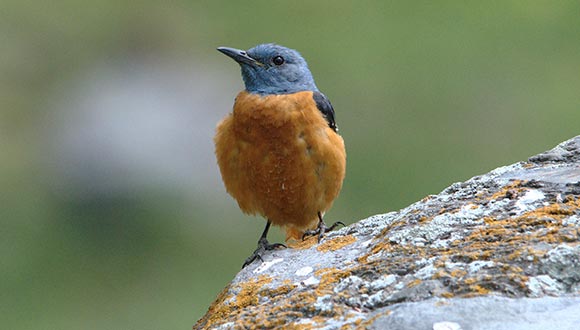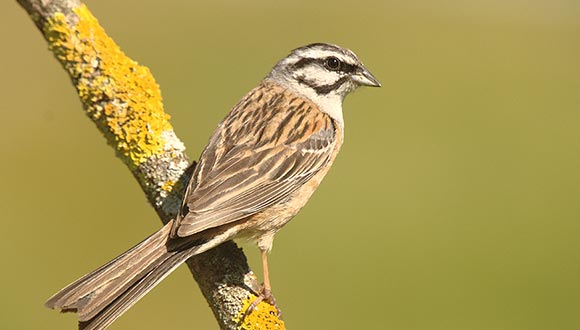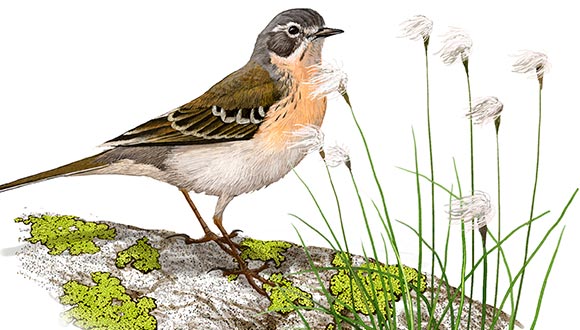Mountain birds in decline in Europe
CREAF and ICO (Catalan Ornithological Institute) researchers Sergi Herrando and Lluís Brotons have participated in a study that shows populations of birds described as “mountain specialists” to have fallen by 10% in a decade in Europe. The situation is even more alarming in the Pyrenees and elsewhere in the Iberian Peninsula, where mountain bird populations fell by 21%.

Published in the scientific journal Global Change Biology in late 2018, a new study shows, for the first time, that populations of birds termed “mountain specialists” have fallen by 10% in Europe since the turn of the century. Climate and land use change could be the main factors in this decline, which is sharper than the mean decrease in populations of more generalist or lowland birds. There is particular cause for concern in the case of the Pyrenees and other mountains in the Iberian Peninsula, where mountain bird populations have plummeted by 21%. Among the researchers involved in the study are Lluís Brotons and Sergi Herrando, both of whom are linked with CREAF, the ICO and other research institutions. Their work included defining what, in ecological terms, constitutes a high-altitude mountain habitat as far as birds are concerned, and establishing which species of mountain birds could be classified as specialists (those found exclusively in mountain areas) and which as generalists (those that also commonly breed in lowlands).
The study examined the populations of 44 species of mountain birds in the Iberian Peninsula, central Europe, Fennoscandia and the UK between 2002 and 2014. The data analysed in the case of the Catalan Pyrenees and Montseny included information from the SOCC (Catalan Common Bird Survey) citizen science project, which the ICO and the Catalan Government's Ministry for Territory and Sustainability have been running for years. For Spain as a whole, the researchers used data from the SACRE bird monitoring project. They found mountain bird population trends to differ from area to area.
The most alarming trends are those observed in Fennoscandia and the Iberian Peninsula. Population numbers were more stable in the Alps and the UK.
Mountain specialist populations were found to have decreased by 10% on average. “This, compared to the 7% fall in populations of common lowlands birds, clearly shows the plight of mountain specialists to be worse than that of birds found at low altitudes”, explains Brotons, a CSIC researcher based at CREAF.
Certain communities and species of living beings are only found in mountains, and some of them are extremely sensitive to climate change. In the event of such a change, the species in question can “move up the mountain” in search of cooler, more humid conditions. Such optimal environments are increasingly restricted to just the highest altitudes, however, and are becoming more and more scarce.
Climate change and habitat loss have led to falls of 21% in Iberian mountain bird populations
The study not only analysed patterns of change in Europe's mountains as a whole, but also on a more local scale. In the Mediterranean context, the researchers examined data for the Pyrenees and the Iberian Peninsula's other mountain ranges.
The general decline observed in Europe was mirrored in the Iberian Peninsula.
Only three of the 14 species of mountain birds analysed in the Iberian Peninsula were found to have experienced population growth, with the other 11 being in decline. Among the species whose numbers had fallen most sharply were the water pipit (Anthus spinoletta), the common rock thrush (Monticola saxatilis) and the rock bunting (Emberiza cia). Overall, the abundance of the species of birds analysed in the Iberian Peninsula dropped by 21% over the 13-year period studied, a fall that is even more drastic than that observed in Europe's mountain ranges as a whole.

The abandonment of mountain pastures, contributing to the spread of woodland and reductions in open space, appears to be a key factor in the aforementioned 21% fall. “Here, in our Mediterranean context, the effects of climate change are probably combined with those of land use change”, says Herrando, an ICO and honorary CREAF researcher. “Nonetheless, we're still analysing data and trying to work out exactly why we're losing biodiversity at high altitudes”, he adds.
The scientists behind the study have stressed the need for further monitoring and research to identify local factors in mountain bird population decline.
According to the team of researchers, monitoring mountain birds is at least as crucial as monitoring lowland birds, although much more complicated due to accessibility and sampling difficulties.

The study was made possible by the efforts of hundreds of volunteer ornithologists from 12 European countries and the organizations that make up the European Bird Census Council (EBCC). In the Iberian Peninsula, researchers from SEO Birdlife and the CENMA (Andorran Snow and Mountain Studies Centre) contributed to the study.
Article:
Aleksi Lehikoinen, Lluís Brotons, John Calladine, Tommaso Campedelli, Virginia Escandell, Jiri Flousek, Christoph Grueneberg, Fredrik Haas, Sarah Harris, Sergi Herrando, Magne Husby, Frederic Jiguet, John Atle Kålås, Åke Lindström, Romain Lorrillière, Blas Molina, Clara Pladevall, Gianpiero Calvi, Thomas Sattler, Hans Schmid, Päivi M. Sirkiä, Norbert Teufelbauer, Sven Trautmann. Declining population trends of European mountain birds. Global Change Biology, 2018; DOI: 10.1111/gcb.14522







